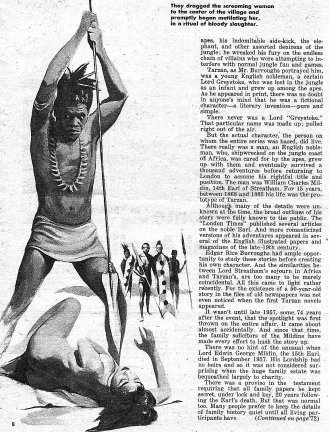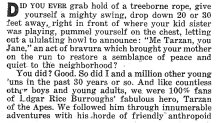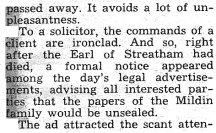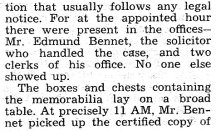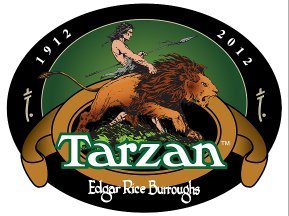| passed away. It avoids a lot of unpleasantness.
To a solicitor, the commands of a client are ironclad. And so, right
after the Earl of Streatham had died, a formal notice appeared among the
day's legal advertisements, advising all interested parties that the papers
of the Mildin family would be unsealed.
The ad attracted the scant attention that usually follows any legal
notice. For at the appointed hour there were present in the offices --
Mr. Edmund Bennet, the solicitor who handled the case, and two clerks of
his office. No one else showed up.
The boxes and chests containing the memorabilia lay on a broad table.
At precisely 11 AM, Mr. Bennet picked up the certified copy of the will,
read the applicable paragraph, asked formally if there were any objections
to carrying out the proviso. Naturally, since no outsider was present,
there were none. Forthwith, the seals were broken and the boxes opened.
Most of the material was typical of that collected by old English families.
There were account books and records dating back to the time of Henry the
VIIIth. Stacked neatly in their containers were yellowing, crumbling letters
from kings, queens, dukes and earls.
"The old boy had some very distant relatives," one of the partners shrugged.
"We might as well ask them if they want this stuff -- if not, we'll just
turn it all over to some museum. There's really nothing startling here.
. ."
The office staff began packing all the papers back into the boxes when
one of the clerks, who had b been rummaging through a brassbound chest,
let out a sudden whoop of amazement.
"Good Lord!" the clerk exclaimed. "Look at this!"
He thrust forward a thick packet of papers that looked as though they
made up a manuscript of some sort. Hand-printed neatly on the cover page
was the following:
"An account of the incredible adventures of Lord William Charles Mildin,
the 14th Earl of Streatham, who lived for nearly 15 years among the apes
and animals of the African jungle.
Astounded, the law clerks took the manuscript and began reading through
it. They were still at the job more than three hours later -- for the manuscript
consisted of more than 1,500 pages of fine, tiny-charactered handwriting.
"By God!" Henry Randolph, the senior partner of the firm, muttered.
"I remember now -- there was some story about Lord Edwin's father.
I heard something strange and weird -- years ago -- when I was only a child.
. ."
The story that then unfolded was odder than odd -- stranger than strange
-- and proved once again that truth can often put fiction to shame.
"I was only eleven," wrote Lord Mildin, the father of the Earl of Streatham
who died in 1937, "when, in a boyish fit of anger and pique, I ran away
from home and obtained a berth as cabin boy aboard the four-masted sailing
vessel, Antilla, bound for African ports-of-call and the Cape of
Good Hope. . ."
Lord William described the voyage from England and down the African
Coast in great and meticulous detail. Then, he told of a violent storm
which caught the Antilla in the Gulf of Guinea -- a storm which,
raging for over 72 hours, wrecked the vessel.
"When the wind subsided, I dis- |


